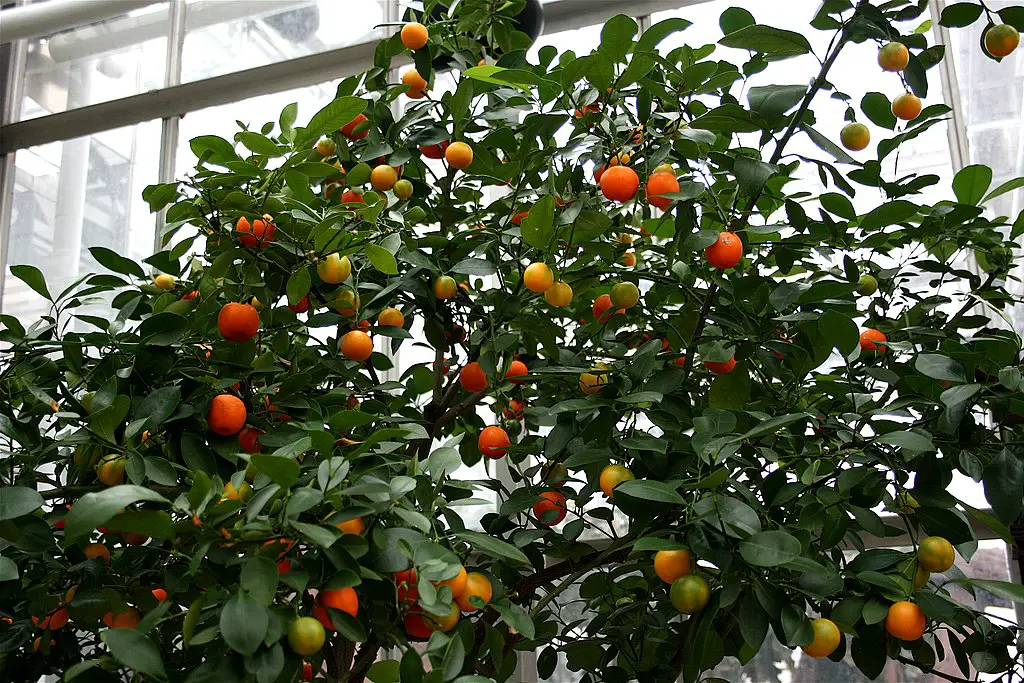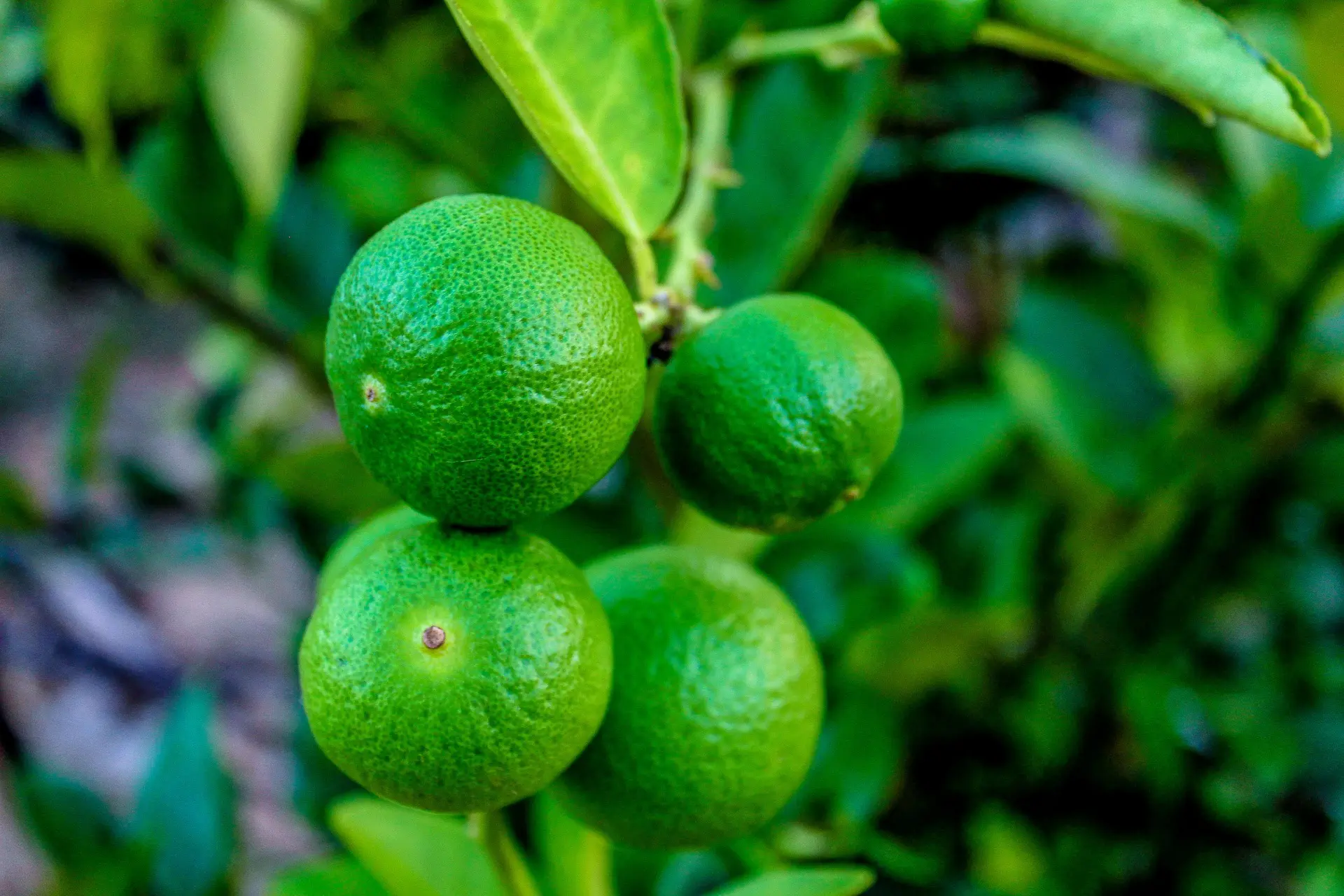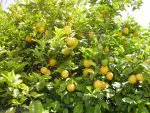This post contains affiliate links. If you buy something from one of our links we may earn a commission. Thanks

Are you thinking about growing a calamondin tree? We will discuss calamondin orange tree care indoors and how to grow and care for your calamondin orange trees.
Calamondin Orange Tree care indoors involves providing abundant light, consistent watering, and moderate humidity. Place the tree near a sunny window and water when the soil’s top inch is dry. Fertilize with citrus-specific fertilizer every 6-8 weeks.
What Are Calamondin Oranges?
Calamondin oranges are a small, tart citrus fruit that is popular in Asian cuisine. They are often used in marmalades, sauces, and cocktails.
While they are typically grown outdoors in warm climates, it is possible to grow calamondin oranges indoors with the right care.
We will discuss calamondin orange tree care indoors and how to successfully grow and care for calamondin orange trees, as well as how to harvest and use their edible fruit.
Calamondin orange trees, whose botanical name is Citrus mitis, are a small, ornamental fruit tree that are native to China. These trees are popular for their small, tart oranges that are often used in cooking and beverages.
Calamondin citrus trees are often used for ornamental purposes because they are a small tree with fragrant flowers.
Most of us will not be able to grow them outdoors in the landscape but as an indoor orange plant with their dark evergreen foliage and fragrant white flowers they can brighten up a room.
If you’re thinking about growing your own calamondin orange tree, it’s important to understand the proper care and maintenance required to keep your tree healthy and productive.
Choosing A Calamondin Orange Tree:
When selecting a calamondin orange tree, it is important to choose a healthy, disease-free tree. This will give you the best chance of success in growing the tree indoors.
There are several options for purchasing a calamondin orange tree, including nurseries and online retailers.
It is also important to consider the size of the tree and whether it will fit in the space you have available. A smaller tree may be more suitable for growing indoors.
Choosing Dwarf Calamondin Trees For Indoors
Dwarf calamondin trees, also known as calamansi or calamondin dwarf, are a small, compact variety of calamondin orange tree that is well-suited for growing indoors.
These trees are ideal for those with limited space, as they typically only grow to be a few feet tall and wide.
One of the benefits of growing a dwarf calamondin tree indoors is that they are relatively easy to care for.
Dwarfing will slow the calamondin orange tree growth rate and keep your calamondin orange tree height much more manageable.
They are tolerant of a wide range of temperatures and do not require as much sunlight as outdoor calamondin trees.
They also have a smaller root system, making them well-suited for growing in pots.
Calamondin Orange Tree Care – The Basics
To care for a dwarf calamondin tree indoors, it is important to provide it with plenty of sunlight and water it regularly.
It is also recommended to fertilize the tree every few weeks to ensure it has the nutrients it needs to thrive.
Pruning may also be necessary to maintain the tree’s shape and encourage new growth.
In terms of harvesting and using the fruit, dwarf calamondin trees will produce smaller oranges than their outdoor counterparts.
However, they are just as delicious and can be used in the same way as regular calamondin oranges.
Overall, dwarf calamondin trees are a great option for those looking to grow calamondin oranges indoors. They are easy to care for and will provide a constant supply of fresh, citrus fruit. So let’s get into it.
Preparing To Plant:
Before planting your calamondin orange tree, it is important to have the necessary tools and materials on hand. This includes a pot, soil, and fertilizers.
The size of the pot will depend on the size of the tree, and it should have sufficient drainage holes to prevent waterlogging. It is also important to use the right type of soil, such as a well-draining potting mix.
To plant your calamondin orange tree, follow these steps:
• Fill the pot with soil, leaving enough space at the top for watering.
• Remove the tree from its container and loosen the roots.
• Place the tree in the pot and fill in around the roots with soil.
• Water the tree thoroughly and add a layer of mulch on top of the soil to help retain moisture.
You can add a slow-release fertilizer to the soil to get the tree off to a good start.
Another trick is to add some pebbles to the bottom of the pot before you fill it.
Place the pot in a pebble tray to provide extra humidity. The pebbles should not be covered over their tops with water.
This is not a watering method but a way to provide extra humidity.
Indoor humidity can become low from the dry air from a heating system. You can mist your plants with a spray bottle.
Also, don’t place your plants next to heating or air conditioning vents, and although they will benefit from good airflow avoid drafty areas.
To care for your calamondin orange tree, it is important to water and fertilize it regularly.
The tree will also need adequate sunlight, so it is important to place it in a location that receives plenty of light.
Pruning the tree may also be necessary to maintain its shape and encourage new growth.
Choose The Right Location
When it comes to planting your calamondin orange tree, it’s important to choose the right location. You should know where to put it even before buying it.
Calamondin orange trees prefer well-draining soil and full sun exposure, so it’s a good idea to plant your tree in an area that gets plenty of direct sunlight.
They also prefer a soil pH between 6.0 and 6.5, so it may be necessary to add lime to your soil to adjust the pH if needed.
When planting your calamondin orange tree, it’s important to give it enough space to grow.
Calamondin orange trees can reach up to 10 feet tall and wide, so be sure to leave enough room for the tree to spread out.
This is why you want to buy a calamondin dwarf tree for indoors.
During the warmer months, you can keep your plant as an outdoor plant but you must be ready to bring it in if low temperatures are in the forecast.
Young plants are more susceptible to cold damage than mature ones.
They say it can be grown in USDA plant hardiness zones 8-11 and it is reported this tree can survive 20 but it would probably go dormant and personally I would not risk this.
Lighting
Calamondin will do really well as a container plant as long as they receive bright light.
Even though it is an indoor plant now they are used to growing outdoors and getting 6-8 hours of direct sunlight.
You can set them near a south-facing window but during the winter months, they will need supplemental lighting.
Use a full spectrum LED grow light that replicates sunshine.
Watering
Proper watering is crucial for the health and growth of your calamondin orange tree.
Calamondin orange trees prefer to be kept evenly moist, but they should not be allowed to sit in standing water.
To determine if your tree needs watering, stick your finger about an inch into the soil. If it feels dry at that depth, it’s time to water.
It’s a good idea to water your tree slowly and deeply to encourage deep root growth. Overwatering can cause citrus plants to get root rot.
Fertilizing
In addition to regular watering, calamondin orange trees also benefit from fertilization.
There are a few different fertilizers that are suitable for calamondin orange trees, including citrus fertilizers.
You can add compost or worm castings to enrich your soil.
It’s a good idea to fertilize your tree once a month during the growing season (spring through fall) using a fertilizer that is high in nitrogen, phosphorous, and potassium.
Avoid using too much fertilizer, as this can lead to leaf burn or other problems.
Pruning And Shaping
Pruning is an important part of calamondin orange tree care, as it helps to encourage healthy growth and fruiting.
Calamondin orange trees should be pruned annually in the late winter or early spring to remove any dead, damaged, or diseased branches and to shape the tree.
Dwarf trees will need much less pruning than full-sized trees. When pruning, be sure to use clean, sharp pruning shears to make clean cuts.
In addition to annual pruning, it’s also a good idea to shape your calamondin orange tree as it grows.
Calamondin orange trees can be trained to grow with a single trunk or multiple trunks, depending on your preference.
To encourage a single trunk, remove any competing branches and prune back the main trunk to encourage lateral branching.
If you prefer a multi-trunked tree, allow the tree to grow naturally and prune off any branches that are rubbing against each other or crossing.
Pest And Disease Management
Like all plants, calamondin orange trees are prone to pests and diseases. Some common pests that can affect calamondin orange trees include scale insects, mites, and aphids.
To control these pests, you can use a combination of natural methods such as introducing beneficial insects and spraying the tree with a mixture of insecticidal soap.
If the infestation is severe, you may need to use a chemical pesticide. However, it’s important to use caution when using pesticides, as they can be harmful to beneficial insects and other wildlife.
Citrus Diseases
Calamondin orange trees can also be prone to diseases such as citrus canker and citrus greening.
Citrus canker is a bacterial disease that causes yellow or brown lesions on the leaves, stems, and fruit of the tree.
Citrus greening, also known as huanglongbing or HLB, is a viral disease that causes the leaves of the tree to yellow and the fruit to become misshapen and bitter.
To prevent these diseases, it’s important to practice good hygiene by cleaning up fallen leaves and fruit and avoiding wounding the tree when pruning.
Harvesting And Using Calamondin Oranges:
When the calamondin oranges are ripe, they will be a bright orange color and will feel firm but slightly soft when squeezed.
If you prefer a sweeter flavor, you can wait until the oranges turn yellow before picking.
Calamondin fruit can be harvested by gently twisting them off the tree or you can use clippers to remove the fruit.
Be sure to use clean, sharp scissors or pruning shears to avoid damaging the branches if you want to harvest that way.
What To Do With Calamondin Oranges?
Calamondin oranges can be stored at room temperature for a few days, or they can be refrigerated in a plastic bag for longer storage.
They can be frozen for longer-term storage. To freeze calamondin oranges, simply wash and dry the fruit, then slice them into thin wedges and place them in a single layer on a parchment-lined baking sheet.
Once they are frozen, transfer the wedges to a resealable bag or container and store them in the freezer.
There are many ways to use calamondin oranges, including making marmalade, adding them to cocktails, or using them in sauces and other dishes.
Growing Calamondin Oranges FAQs
Caring for a Calamondin Orange Tree indoors can be a rewarding experience, but it does come with a set of challenges and questions.
Here are some frequently asked questions and answers to help guide you through the process.
Q: How much light does a Calamondin Orange Tree need indoors?
A: It requires at least 6-8 hours of bright, indirect sunlight daily. You can use an LED grow light for supplemental light.
Q: When should I fertilize my Calamondin Orange Tree?
A: Use a citrus-specific fertilizer every 6-8 weeks to support growth and fruit production.
Q: Can I repot my Calamondin Orange Tree?
A: Yes, repotting every 2-3 years can be beneficial, but make sure to use a well-draining soil mix.
Q: How do I manage pests on my indoor Calamondin Orange Tree?
A: Insecticidal soap or neem oil can be effective in controlling common pests like spider mites or aphids.
Final Thoughts
Growing calamondin oranges indoors is a rewarding hobby that allows you to enjoy fresh, citrus fruit year-round.
With proper care, including proper planting and location, regular watering, fertilizing, annual pruning, shaping, and pest and disease management, you can enjoy a healthy and productive calamondin orange tree for years to come.
With the right care, your calamondin orange tree can thrive and produce a bountiful harvest.
Whether you use the fruit in cooking or simply enjoy them as a refreshing snack, calamondin oranges are a delicious and versatile addition to any home.
Read more at my Growing Indoor Citrus Trees (The Complete Beginners Guide!)











